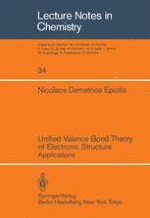1983 | OriginalPaper | Buchkapitel
Geometric Isomerism: The Simplest Illustrator of Orbital Symmetry Control of Molecular Stereochemistry
verfasst von : Nicolaos Demetrios Epiotis
Erschienen in: Unified Valence Bond Theory of Electronic Structure
Verlag: Springer Berlin Heidelberg
Enthalten in: Professional Book Archive
Aktivieren Sie unsere intelligente Suche, um passende Fachinhalte oder Patente zu finden.
Wählen Sie Textabschnitte aus um mit Künstlicher Intelligenz passenden Patente zu finden. powered by
Markieren Sie Textabschnitte, um KI-gestützt weitere passende Inhalte zu finden. powered by
The thermal conversion of 1,3-butadiene to cyclobutene may occur in a conrotatory or a disrotatory fashion. In the former case, an axis of symmetry is maintained along the reaction coordinate while in the latter case a plane of symmetry is preserved during the conversion or reactants to products. This difference with respect to the existing symmetry elements becomes responsible for a difference in the symmetry labels of reactant and product orbitals. In turn, this becomes responsible for the existence of a barrier in the case of disrotation and the absence of a barrier in the case of conrotation at the level of Hückel MO theory. This is clearly revealed by the Longuet-Higgins-Abrahamson-Woodward-Hoffmann MO correlation diagrams1 for con- and dis-rotatory ring closure of 1,3-butadiene. The conrotatory ring closure of 1,3-butadiene is termed a symmetry “allowed” and the disrotatory ring closure of the same molecule is termed a “forbidden” reaction.
